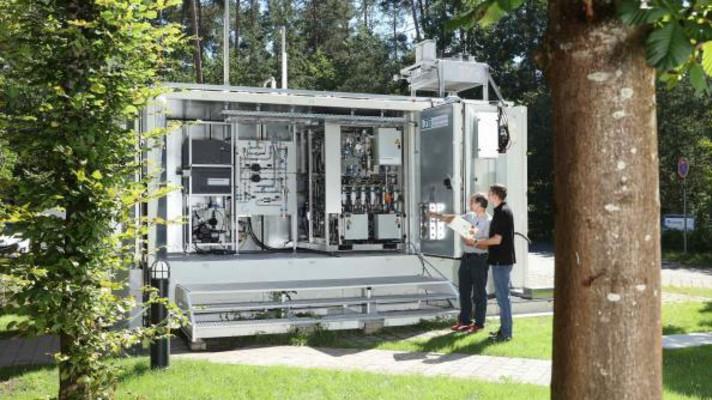Long-term energy storage system uses hydrogen technology
A unique system for the compact storage of large quantities of energy is set up at Fraunhofer IISB in Erlangen and integrated into a modern DC power grid. As part of the center of excellence for electronic systems LZE, research is being conducted on how such an energy storage unit can contribute to the safe and clean energy supply of industrial plants and larger building complexes.
The storage system is being set up as part of an LZE pilot project, titled DC backbone with current-gas coupling. The basic concept is to generate hydrogen from excess electrical energy, for example from a local photovoltaic system, and to store it safely and at high energy density in an organic carrier, even over extended periods of time. For later use, the hydrogen can be separated from the carrier again and converted into electrical energy by a fuel cell. The fuel cell was put into operation as early as April as the first main component of the energy storage system. With the built-in components, 25 kilowatts of electrical power can be stored. The fuel cell system used is based on the low-temperature PEM technology (PEM: Proton Exchange Membrane). The PEM design basically allows the fuel cell to be switched to its operating state within a few minutes after a cold start. Fast operational readiness is essential, for instance to cover load peaks in industrial machines.
The liquid carrier used for hydrogen storage is known as LOHC (Liquid Organic Hydrogen Carrier). The liquid carrier takes up large amounts of electrolytically produced hydrogen via a chemical reaction and can then be stored safely under normal ambient conditions for pressure and temperature. Only under very specific conditions within a chemical reactor the hydrogen can be released from the carrier again. As far as storage and transport requirements are concerned, the carrier can be compared with conventional diesel fuel - a major advantage over other hydrogen storage technologies, which usually require high pressures or very low temperatures. The carrier is already widely used in the industry, but as a thermal oil for the heating and cooling of processes. In the application as LOHC, however, it allows the repeated storage and release of energy in a closed circulation process. Unlike fossil fuels, the LOHC is not consumed in the process, but can be loaded and unloaded with hydrogen. In the container in Erlangen, currently about 300 liters of LOHC can be stored, which corresponds to an energy stored in hydrogen of almost 600 kilowatt hours. This is sufficient to cover the power requirements of a smaller industrial plant over several hours. However, the amount of stored energy can easily multiplied by means of additional tank containers. Thus, for example, larger enterprises, data centers or hospitals can be supplied over longer periods of time.
With the new research facility, the scientists plan to investigate various questions: How can a fluctuating energy generation process be recorded with a LOHC-based energy storage system, e.g in the field of photovoltaic installations installed on site? How can such systems be compactly integrated into a single container? And how can such an installation be integrated efficiently into industrial energy networks? At Fraunhofer IISB, the plant is connected to the local DC network. Such networks enable more overall efficient operation by avoiding unnecessary conversion losses from direct current to alternating current in the interaction of local producers, storage units and consumers.
The research on the globally unique energy storage system provides important insights into how storage systems based on liquid hydrogen carriers can be integrated into local energy systems. "A first important step has been taken with the commissioning of the fuel cell system. Now we are looking forward to the next results ", says project co-worker Johannes Geiling. "An important research focus will be to find the most suitable operating system for the storage system," Geiling adds. With the right operating strategy, the LOHC system will enable renewable energies to be more closely integrated into industrial plants, medium-sized companies or larger building complexes and neighborhoods, thereby increasing energy self-sufficiency.
August 10, 2017 // By Christoph Hammerschmidt
